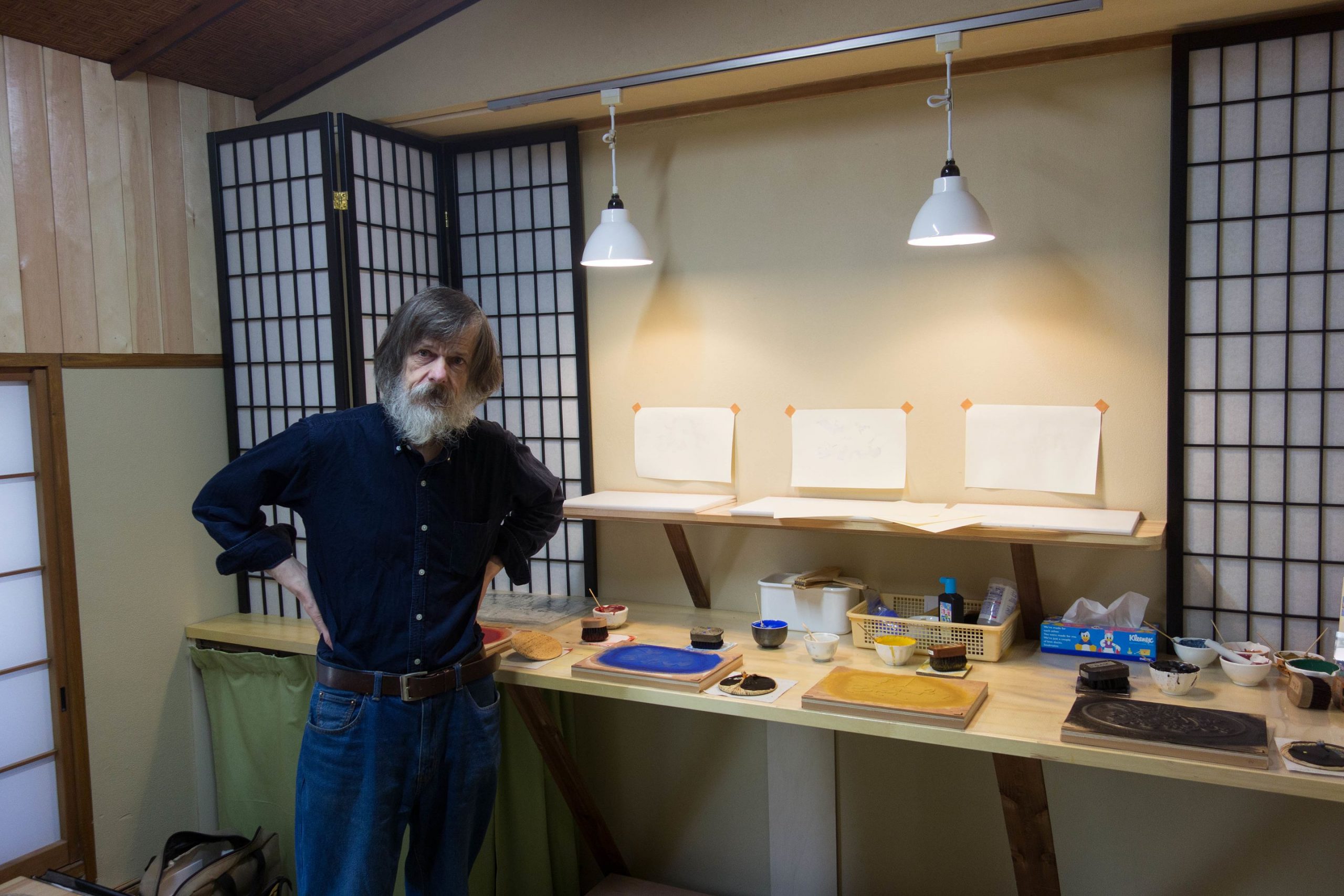The Unlikely Life and Wisdom of Woodblock Printmaker David Bull
In the 1980s, Bull left his native Canada to pursue traditional woodblock printmaking in Japan. Decades later, his popular YouTube channel is helping to preserve a dying art form. The post The Unlikely Life and Wisdom of Woodblock Printmaker...

To casual viewers, he is the long-lost cousin of Bob Ross: a guy with fuzzy hair and a soothing voice creating art in front of a camera. To his devoted fan base, he is David Bull, the woodblock printmaker coming to you live from his shop in Asakusa, Tokyo.
Raised in Canada, Bull became interested in traditional Japanese prints and printmaking at a young age, at a time before the internet. Moving to Japan in the eighties, he taught English to support his family before managing to turn his hobby and passion into a legitimate business. His first series of commercially produced prints, “Hyakunin Isshu”—one hundred images accompanying a well-known collection of one hundred late-medieval Japanese poems—took close to a decade to finish, at a rate of ten unique and handmade prints per year.
In an era inundated with mass production, Bull’s small runs of handmade prints have no shortage of buyers. What’s more, these prints are perhaps made even more in demand due to the growing popularity of Bull’s YouTube channel. Following its creation in 2011, Bull’s YouTube is filled to the brim with videos exploring the history of Ukiyo-e—a school of Japanese woodblock printing and painting, known to depict subjects from everyday life, literally meaning “pictures of the floating world”—and showing the slow but meticulous production process at Mokuhankan, Bull’s shop and studio in Asakusa. One of Bull’s most popular videos, an hour-long recollection of his experience befriending and learning from a top-of-his-game carver by the name of Ito Susumu, has been viewed by more than three million people, some of whom sharing in the comments about how much they enjoy listening to Bull as they fall asleep at night.
Despite frequent comparisons to Ross, there is more to David Bull than ASMR (or autonomous sensory meridian response). With an audience of some one hundred seventy-eight thousand subscribers and patrons, his YouTube channel is playing a key role in preserving and spreading appreciation for a centuries-old craft that, like so many other trades from the distant past, has long been in decline, only to find a second life in remote yet cozy corners of the internet.
“It wasn’t that I didn’t like Canada,” Bull says of moving to Japan, a decision he made in 1986. “I have many fond memories of my life there. It’s that I found Japan to be a very congenial place to live, that I fit in here. I’m not Japanese and never will be, but it’s just that the basic structures of society here—the rights, responsibilities, and patterns of life—all seem to fit into my character.”
Almost forty years later, Bull has fully acclimatized, addressing me in my email as Tim-san and, as one person pointed out in the comment section of one of his videos, saying “ano” instead of “uh” whenever he momentarily loses his train of thought. And yet, I couldn’t help but wonder if he encountered the same sense of impenetrableness that so many other Japan-based expats are said to have experienced.
“This is my home,” he answers when I talk to him on Zoom, his calm, eloquent demeanor identical to the person seen in his videos. “I think anyone who still feels a disconnect after having been here as long as I have, wouldn’t be here.” He mentions a study he once read about in the Japan Times, which showed that, of all the people moving to Japan, 90 percent leave within the first year, while 90 percent of those who stay leave in the following three years, and so on. “As to whether I’m still a foreigner, I work with Japanese people every day, and every day I am reminded that I don’t think the same way as they do. Luckily, the culture is very forgiving and allows people with different [mindsets] to live here… Japan has always been open [to] welcoming to new ideas.”
 From David Bull’s YouTube channel.
From David Bull’s YouTube channel.Less welcoming were the carvers Bull hoped to learn from, a quality that he attributes to their trade. Printers are friendlier, he explains in one of his videos on Ito-san, whereas carvers can seem cold and reserved by comparison. Bull would be the first to note that this callousness is not because these carvers are mean, but perhaps because, back in the day, they had to keep their techniques a secret from rival workshops. Bull’s repeated attempts to cozy up to masters like Ito-san, only to have doors close right in his face, reminded me of similar situations found in many examples of koan and mondo, where Zen monks refuse to give easily discernible answers to their students when probed about the secrets of enlightenment. But Bull is quick to stop me in my tracks.
“It seems that you have the same kind of viewpoint I did before I came to this country,” Bull says. “Whether we’re studying aikido or printmaking, we Westerners have this bizarre idea that over there, in that magical, wonderful land, there are masters and acolytes. But that’s just bullshit, top to bottom. Japan is just another country full of people just doing their jobs, the rice maker making rice, the plumber plumbing. When you walk up to a ‘master’ and beg them to teach you their secrets, they’ll ask you what you’re smoking!
“I’m exaggerating a little bit here, but the point is that we have made up this thing that doesn’t really exist. Ito-san was a busy guy. He had no children. The world he worked in all his life was in decline, and he knew it. But he wasn’t thinking the way we do: ‘We should rebuild this and save it!’ His job was to sit there, carve blocks, and [to] do it as well as he [could]. ‘No, I can’t help him. I’m busy, and that foreigner will ask so many questions.’ He had no responsibility toward me, no reason to think that he needed to take his skills and pass them on to me.”
Yet with time, patience, and perseverance, Bull became as close to Ito-san as a man like that was going to let him. Bull became so close, in fact, that after his passing—which came not long after he stubbornly refused to be driven home in the pouring rain— Ito-san’s widow sent Bull a handful of videotapes he had recorded for a television program. She knew that these videos—which contained hours upon hours of unedited footage of Ito-san carving— would prove invaluable to Bull, as she had seen how much those rare opportunities to watch Ito-san work had helped the nosy Canadian.
Instead of “master” Bull prefers the term “craftsman.” Traditional carvers aren’t artists, even if the work they make is beautiful and touching; in truth, they’re no different from rice makers and plumbers: just people doing their job. The revelation had come to Bull when he asked Ito-san, who was working on yet another reproduction of Hokusai’s Great Wave, if he ever tired of carving the same blocks over and over again. “If you were a craftsman, shokunin, you’d never ask me that,” the old man said. “I’m a shokunin. Whatever they send me, I carve it. [If] you only carve stuff you like, it’s [still just] a hobby for you.”
Years later, when working on a print for his “Beauties of Four Seasons series, Bull made a tiny mistake that required him to recarve an entire block from scratch, costing him dozens of hours of work. Rather than get upset at the situation, Ito-san’s words echoed through Bull’s head. If Ito-san’s critique had applied to Bull then, it didn’t any longer. “No, it’s not a hobby,” he triumphantly tells his subscribers at the end of his video. “I’m a craftsman.”
Whether his craftsmanship was cut from the same wood as Ito-san’s, though, is another question. After the old carver’s death, Bull got his hands on his reluctant teacher’s carving knife, and recalled being shocked at how small and delicate it was compared to his own. Even at his age—Bull must have been in his 50s—he still feared he wasn’t skilled enough to use a knife like that without breaking it.
It would take another couple years before he dared to make another attempt at using the knife, picking a reproduction of a design by Toyohara Chikanobu for just the occasion. Managing to carve out its many intricate details, including several dozen individual strands of hair, was something he never thought he’d achieve. Unfortunately, he maintains, he’ll never be able to do it ever again.
“There are two aspects to this,” he says of carving. “One is experience: what I did not know, I learned. Ideally, this is always an upward trend: I’m still learning, especially now that we have two hotshot young carvers here at Mokuhankan who are technically superior to me.”
On the other side, though, “carving is athletics, a physical act. It requires a body with muscles, eyes. I’m 72, and you probably know where the rest of this story is going. If one is an ascend, the other is a decline. As an athlete, I’m well past my prime, and would be toast if this were a competitive environment. I’ve got glaucoma. I now need lenses and a microscope, and I’m very much struggling.”
If there’s one positive, it’s that less time at the carving bench means more time behind the camera. “I was late to the internet, as I’m late to many things,” he admits as the conversation shifts to YouTube. “I initially thought that this website was the cesspool of the internet, with the comment section and all. It may sound silly, but I now think it’s truly one of the glories of human culture. Anybody who is doing something, wants to learn about something, [whether that be] fixing your plumbing, thinking about the meaning of life, whatever—it’s there, and the fact that I am one of the little [stones] that make up this wonderful castle makes me both happy and proud.”
“If you only carve stuff you like, it’s still just a hobby for you.”
It’s a good thing his YouTube channel came along when it did because, just as with bonsai cultivation, traditional woodblock printmaking has been in decline for centuries, with what was once considered the backbone of Japanese visual culture slowly morphing into the niche, stuck-in-time ecosystem that exists today. And although Bull and Mokuhankan play an undeniable role in keeping this ecosystem alive, he fears he hasn’t been doing enough.
“Looking back, I think I have really failed in a vitally important thing. I speak Japanese, but my native language is English, and the original purpose of our YouTube channel was to show people abroad what I was doing, so I made my first videos in English. They were successful. I made some more, again in English. People from across the world see them. But young Japanese people generally don’t browse YouTube in English; they do it in Japanese, and so we created this situation where pretty much everyone except the Japanese were learning about this craft of mine.”
He marches on without pause, clearly having given thought to this topic before. “More important than our own jobs, the preservation of Mokuhankan, [or] getting materials, is to show young Japanese the same interesting and exciting story we have shown people like you in the West.”
Part of why Bull gets so worked up is that he knows that, contrary to reports and news articles claiming that young Japanese have little to no interest in traditional Japanese crafts, they are, in fact, attracted to them. “A lot of young people don’t want to become salarymen, a robot riding the train to work in the morning,” he explains. “The culture here has changed so much recently. The easiest analogy is North American culture in the 1960s: I don’t want to be the man and work for a corporation. I want to be something else, even if I don’t exactly know what ‘something else’ is. People back then didn’t want to do what their parents were doing, and Japan now is full of such individuals.”

 ShanonG
ShanonG 






























